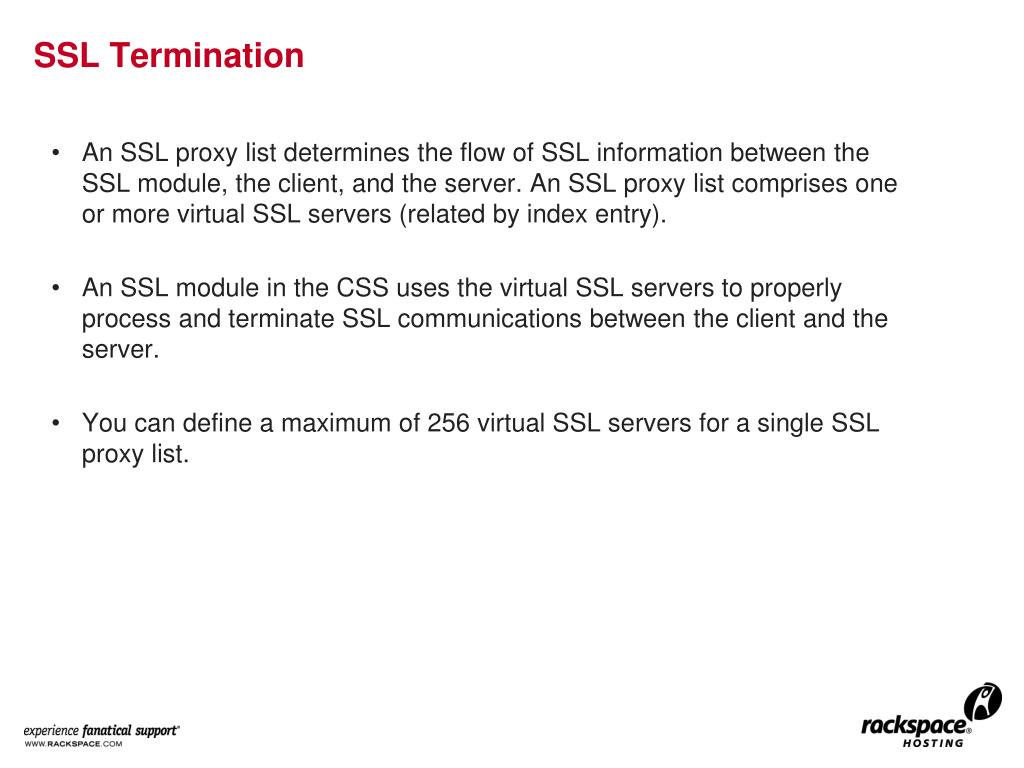In the vast expanse of digital communication, SSL termination operates as the vigilant guardian standing at the gates of an encrypted kingdom. It is the meticulous process of decrypting Secure Sockets Layer (SSL) traffic at a designated checkpoint, often a load balancer or a web server equipped for this task. This article delves into the enigmatic world of SSL termination, elucidating its mechanism, advantages, and appropriate contexts for utilization.
To comprehend SSL termination, one first needs to grasp the essence of SSL itself. Imagine SSL as a robust suit of armor worn by data packets as they traverse the treacherous landscapes of the internet. It provides an impenetrable shield that safeguards sensitive information from prying eyes. However, beneath that formidable exterior, SSL packets require unlayering for further processing; thus enters the concept of termination.
At its core, SSL termination is akin to a skilled locksmith who carefully unlocks a door to enable entry into a secure enclave. When a user connects to a web service via HTTPS, their data is initially encrypted and sent to the server hosting the application. An SSL terminal decrypts this data, allowing it to be inspected, modified, or forwarded to an internal server without the need for continuous decrypting and re-encrypting along the entire communication path.
One might wonder about the technical intricacies involved in SSL termination. At its simplest, the process occurs in three cardinal phases: handshake, encryption, and data transmission. During the handshake phase, the client and server engage in a protocol to establish a secure connection. This involves verifying digital certificates and exchanging encryption keys. The decryption occurs post-handshake when data packets reach the SSL termination point. Subsequently, the plaintext data is transmitted to its final destination, often intended for internal servers that may not possess SSL capabilities.
Reflecting further, SSL termination presents myriad benefits. One of the most notable advantages is the alleviation of processing burdens on internal servers. When SSL traffic is terminated early, internal servers are relieved of the cryptographic overhead. They can concentrate solely on processing application logic, leading to enhanced performance and responsiveness.
Moreover, SSL termination facilitates the implementation of load balancing techniques. Much like a traffic manager orchestrating the smooth flow of vehicles at a busy intersection, a load balancer can efficiently distribute decrypted traffic across multiple servers. This seamless distribution enhances redundancy and augments the overall robustness of the service.
An illustrious feature of SSL termination is the potential for more profound traffic analysis and monitoring. Decrypting the SSL traffic enables security tools to inspect data packets for malicious content or anomalous behavior. In a landscape where cybersecurity threats proliferate, this capability is akin to outfitting a fortress with vigilant scouts who can detect intrusions before they escalate into significant breaches.
Yet, with every benefit comes an inherent caveat. Implementing SSL termination necessitates astute decision-making regarding where and how to deploy the process. Data breaches and security vulnerabilities can stem from mishandling decrypted data within insecure internal networks. Thus, it is crucial to ensure that subsequent data handling adheres to rigorous security standards. Careful evaluation of the network architecture and potential vulnerabilities is paramount when opting for SSL termination.
So when should SSL termination be utilized? Several scenarios warrant consideration:
- High-Volume Web Applications: For web applications that handle substantial traffic, SSL termination can optimize system performance. By offloading decryption to dedicated devices, business logic servers can operate more efficiently.
- Content Delivery Networks (CDNs): When utilizing CDNs, SSL termination can serve to accelerate content delivery. CDNs can cache and serve content faster when they handle the SSL decryption, enhancing the user experience.
- Intrusion Detection and Prevention Systems: Organizations wishing to communicate securely yet monitor their systems will thrive with SSL termination. It allows for inspection of traffic for malicious activity without compromising secure communication.
- Microservices Architecture: In microservices environments, where services are often located in different containers, SSL termination can simplify complex interactions by managing SSL connections efficiently.
As technological landscapes evolve, businesses must remain vigilant. The advent of new protocols such as TLS 1.3 necessitates reevaluation of existing architectures, with SSL termination at the forefront of many discussions. The capability to terminate SSL connections offers not only immediate performance advantages but also initiates a pathway for logistical optimization within digital ecosystems.
In conclusion, SSL termination is not merely a technical process but rather a critical aspect of modern cybersecurity architecture. It stands as an intermediary, balancing the need for secure, encrypted communication with the practicality of effective data processing and monitoring. In the grand scheme of digital communication, SSL termination can be likened to a warm light breaking through the fog, enabling clarity and safety in an otherwise opaque environment. Understanding when to deploy SSL termination transforms it from a technical consideration into a strategic asset, propelling businesses toward resilient, secure online operations.









Leave a Comment